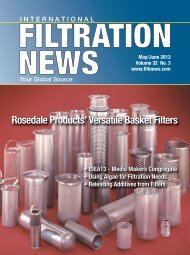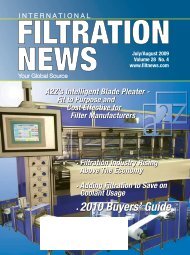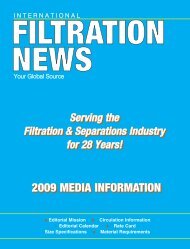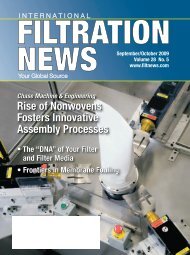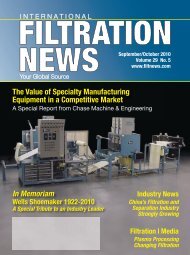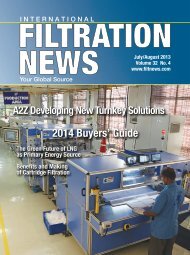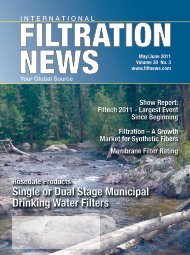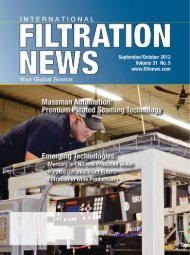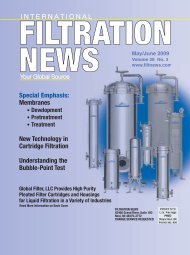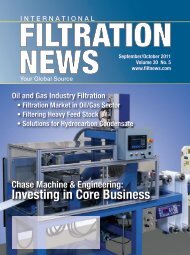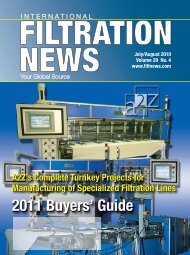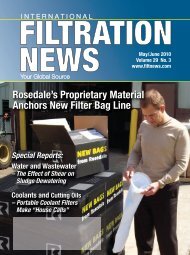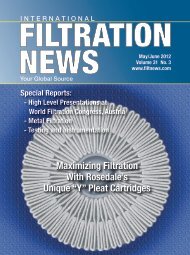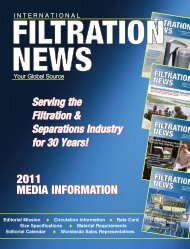2013 Buyers' Guide 2013 Buyers' Guide - Filtration News
2013 Buyers' Guide 2013 Buyers' Guide - Filtration News
2013 Buyers' Guide 2013 Buyers' Guide - Filtration News
Create successful ePaper yourself
Turn your PDF publications into a flip-book with our unique Google optimized e-Paper software.
to provide full physical adsorption<br />
characterizations of activated carbons<br />
and other sorbent materials. This robust<br />
and rugged instrument allows the<br />
activated carbon industry to solve prior<br />
refractory questions for clients. Also,<br />
GAED solves modern and classical<br />
problems and guides new R&D product<br />
developments more cost effectively,<br />
compared to existing test methods.<br />
An archival record of how GAED<br />
works and some applications is available<br />
(1). The most recent publication<br />
points out GAED’s use to reveal markets<br />
available for a particular AC or<br />
new material (2). The AC industry is in<br />
the process of transforming from an art<br />
to a science and GAED and other testing<br />
methods facilitate this important<br />
transformation.<br />
STRATEGY FOR ANSWERING QUESTIONS<br />
GAED strategy is to use a standardized<br />
set of test parameters on field samples<br />
and known commercial<br />
benchmark AC samples. GAED measurements<br />
along with ASTM and other<br />
needed laboratory methods satisfy the<br />
lab part. Professional knowledge about<br />
different AC products and applications<br />
coupled with lab, results in a useful<br />
flexible problem solving strategy.<br />
CHARACTERISTIC CURVES AND USES<br />
It is important to clean the test sample<br />
before the GAED test is performed.<br />
When comparing a group of samples<br />
one should provide dry samples to the<br />
GAED laboratory. Some field samples in<br />
the testing group may have more moisture<br />
and volatile matter. The GAED provides<br />
these values as a measure of<br />
cleanliness. It is important to know the<br />
cleanliness of purchased AC. Do not<br />
pay for excess water on the carbon.<br />
After samples are thermally cleaned<br />
they are challenged with 1,1,1,2-Tetrafluoroethane<br />
(TFE) gas at 240˚C. This<br />
gas was chosen because it is difficult to<br />
be adsorbed by AC (at 240˚C only the<br />
highest adsorption energy sites are able<br />
to capture TFE from the mobile gas<br />
stream), its low cost, available worldwide,<br />
non-toxic, and friendly to the environment.<br />
After the high adsorption<br />
energy pore volume is determined at<br />
240˚C the temperature program lowers<br />
the sample temperature hot to cold<br />
slowly reaching a quasi-equilibrium<br />
state before starting the next incremental<br />
temperature lowering. Physical adsorption<br />
is a function of temperature,<br />
the lower the temperature the better<br />
the adsorption capacity, weight of TFE<br />
picked up. Lowering the temperature<br />
until -20˚C avoids TFE condensation<br />
on the sample. Condensation on the<br />
sample is a false positive for adsorption.<br />
This resulting hot to cold curve is<br />
called the adsorption Characteristic<br />
www.filtnews.com • August 2012 • 31<br />
Curve; it is characteristic of the sample<br />
when it is run thru the standard GAED<br />
test parameters. At the lowest temperature<br />
the temperature program is reversed,<br />
cold to hot, to obtain the<br />
desorption Characteristic Curve. AC<br />
does not demonstrate any hysterias, i.e.<br />
the adsorption and desorption curves<br />
are the same. Other physical adsorbents<br />
do show hysterias.<br />
From the graphical Characteristic<br />
Curves in Figure 1 polynomial equations<br />
are derived, see Table 5. These equations



